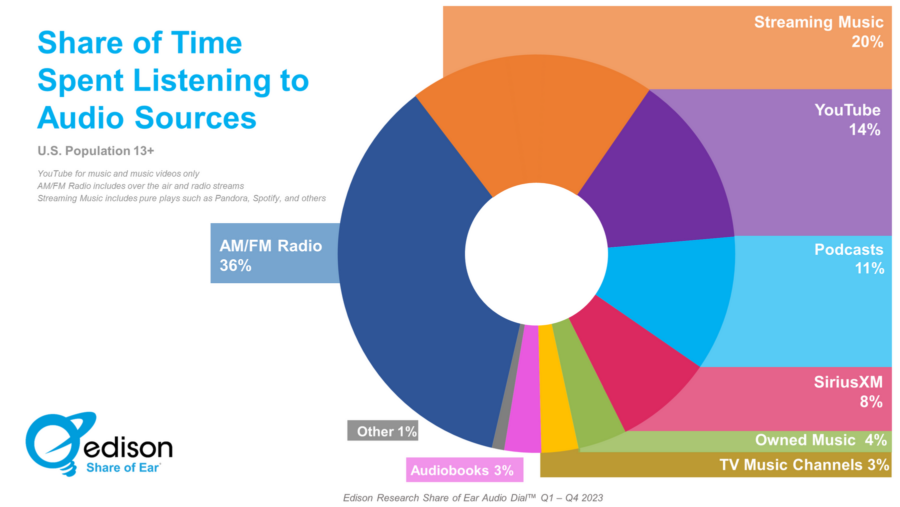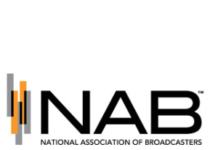
As its Share of Ear study enters its tenth year, Edison Research is giving a first look at its Q4 survey results. Each quarter, Edison asks participants how much time they spend on different audio platforms – at the end of 2023, radio was still in charge, but it lost ground.
The Share of Ear Audio Dial shows that Americans aged 13 and older spent 36% of their daily listening time with over-the-air radio and AM/FM streams, which fell a percentage point since Q3. This was the second percentage point lost in 2023, with an equal drop from Q1 to Q2.
The majority of this listening, constituting 31 percentage points, is attributed to traditional over-the-air signals.
Conversely, Streaming Music saw an increase, reaching a 20% share of daily listening time for the first time. This includes services like Spotify, Tidal, and Apple Music. As streaming platforms grow, the share of owned music, which includes physical formats such as CDs and vinyl, an well as personal digital files, decreased by one point.
All other categories, including YouTube and podcasts, remained constant from their Q3 results.

While radio still commands more listening time than Streaming and YouTube combined, the margin has fallen within two percentage points.
To celebrate the ten-year milestone for Share of Ear, Edison Research is teasing special reports on the changes in audio consumption over this past dynamic decade. These reports are anticipated to provide valuable views into how Americans’ listening habits have transformed, offering a reflective look at the trends that have shaped the audio space while hopefully gleaning strategy for the future.










Live and local is no longer, in many cases, a financial possibility. Voice tracking is NOT the enemy. HOW it’s being done IS.
However LOCAL IS important. But that’s just one of the issues. Shows should be tracked when being done IN THE MOMENT and NOT starting with “Hey did you hear about what (celebrity) did today?” The breaks should start with frequency/calls or code call, just like it always done with local radio.
Personality should be ENCOURAGED, not discouraged. It is for most, though a PPM world and the breaks have to be short. The days of 2 minute long jock breaks died with KHJ in 1965 and they shouldn’t come back.
Conservative risk taking MUST be allowed. How to fix young demo issues? The same basic way radio has always done it. Go to the high schools and colleges and ASK YOUNG PEOPLE HOW TO MAKE RADIO MORE INTERESTING TO THEM. Then implement the suggestions they tell you.
Radio MUST find better ways to monitize itself. Because the days of the 10-20 minute long stop sets need to be GONE as soon as humanly possible. Whether through sponsorhip half hours with a live read spot at the beginning and end (odd, kinda like a podcast, huh?) and maybe a brief 2 minute cluster of spots inside. Remember – to a listener, a unit is one commercial. Listeners do NOT and never have counted commercials by the minute. And, with all due respect owners, you only known this for about 35 years. That research is still in your filing cabinets, isn’t it? Perhaps you need to go back and re-read it.
Accept that right now the biggest possible radio audience is over 40, maybe over 50. Why are there few if any oldies stations? Or traditional Classic Rock stations? Programmed correctly, they can reach an over 35 audience that reaches to 70. And you can sell that. If you can sell these horrible AM syndicated talk stations with no local programming or these syndicated sportstalk stations that are getting 0.4’s and 0.5’s, you should be able to sell 35 to 70. As you try to fix the problems that are causing the younger people to abandon radio. Play the old songs, but let the personalities live in the moment and in their local areas.
Yes, I know. Stockholders don’t tend to like conservative risk taking. But trying to please stockholders is driving listeners to that other thing called the internet, of which, you, Dear Radio are also failing to conquer.
But, don’t believe me. I’m just a guy who’s spent 50 years in this business and for the last 25 or so have watched you screw it up. Debt is a horrible thing. It almost killed the first station I worked for in 1974. It did kill a great radio company for which I worked in the mid 80’s to mid 90’s that had given personalties like the late Terry Dorsey, and people like Fred Winston, Jim Quinn and others jobs while they were coming up the pike. And now it’s killing some of you and is trying to take the entire industry with it.
The clock is running, and it’s not in our favor. Good luck.
LIVE AND LOCAL. Commoditized brands offer no compelling reason to listen. Local hosts, programming and promotions were once Radio’s USP, but local cutbacks in favor of corporate “VP’s of Fancy Buzzwords” with top-down initiatives have painted each market with the same brush. As national revenue continues its pricing race to the bottom, concentration on ROI instead of CPM will be Radio’s lifeline. But that begins with a compelling reason to listen, which is generated from the bottom-up, not from the top-down.